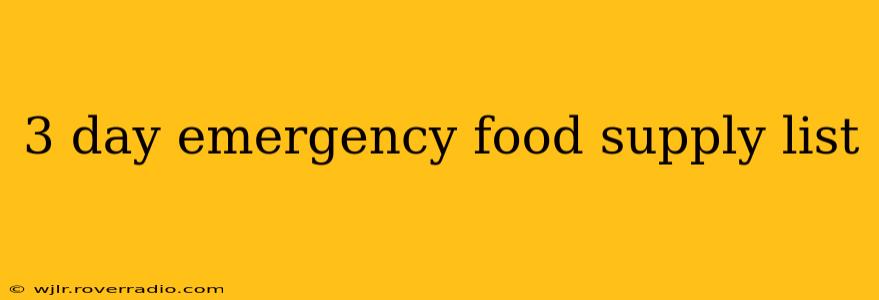A well-stocked emergency food supply is crucial for weathering unexpected events, from power outages to natural disasters. This 3-day emergency food supply list focuses on non-perishable, nutritious options that require minimal preparation, ensuring you and your family stay safe and fed during a crisis. Remember, this list is a starting point; adjust quantities based on your household size and individual dietary needs.
What to Include in Your 3-Day Emergency Food Supply?
Your emergency food kit should prioritize foods that are easy to prepare, non-perishable, and provide essential nutrients. Avoid relying solely on sugary or processed foods; aim for a balanced intake of carbohydrates, proteins, and healthy fats.
Non-Perishable Staples:
- Canned Goods: Beans (kidney, black, pinto), tuna, salmon, chicken, fruit (peaches, pears, pineapple), vegetables (corn, green beans, mixed vegetables). Choose low-sodium options whenever possible.
- Dried Foods: Dried fruits (raisins, apricots), pasta, rice (white or brown), oats (rolled or quick-cooking), lentils. These are lightweight and have a long shelf life.
- Protein Sources: Peanut butter (in a sealed jar), nuts (almonds, walnuts), protein bars (choose those with minimal added sugar). These offer sustained energy.
- Crackers & Bread: Crackers (saltines, graham crackers), hardtack biscuits. Choose sturdy options that won't crumble easily.
- Other: Powdered milk (long shelf life, requires water for reconstitution), honey or maple syrup (natural sweeteners), bouillon cubes (for flavoring water), coffee or tea (for comfort and hydration).
How Much Food Should I Store?
A good rule of thumb is to have at least a three-day supply of food per person. This means enough for breakfast, lunch, and dinner for each day. Consider factors like dietary restrictions, preferences, and potential needs for infants or those with special dietary requirements when calculating quantities.
What About Water?
Water is just as crucial as food in an emergency. Remember to include at least one gallon of water per person per day. Water needs will vary depending on the climate and the level of activity.
What are Other Important Considerations for my Emergency Kit?
Beyond food and water, consider including:
- Manual can opener: Essential for accessing canned goods.
- Utensils: Spoons, forks, knives.
- Paper plates and napkins: For easy cleanup.
- First-aid kit: To address minor injuries.
- Radio: For emergency broadcasts.
- Flashlight and extra batteries: For light in the dark.
- Copies of important documents: Identification, insurance, medical information.
How Long Do Emergency Foods Last?
The shelf life of emergency food varies greatly depending on the type of food and its storage conditions. Always check the "best by" or "use by" dates and rotate your supplies regularly to ensure freshness. Proper storage in a cool, dry, and dark place is key to extending the shelf life of your emergency food supplies.
Can I Use MREs (Meals Ready-to-Eat)?
MREs are another option for emergency food storage. These are pre-packaged, shelf-stable meals that require minimal preparation, but they can be more expensive than other options on this list.
What About Pet Food?
If you have pets, remember to include a supply of their food in your emergency kit. Their nutritional needs are just as important as yours.
How Often Should I Rotate My Emergency Food Supply?
It's crucial to regularly rotate your emergency food supply every 6 months to a year to maintain freshness and prevent spoilage. Use the "first in, first out" (FIFO) method, consuming the oldest items first. This ensures that you always have fresh, safe food available. Checking expiration dates on a regular basis is extremely important.
This comprehensive 3-day emergency food supply list helps you prepare for unexpected situations. Remember, preparedness is key to staying safe and secure during emergencies. Remember to adapt this list to your specific needs and regularly check and rotate your supplies.
